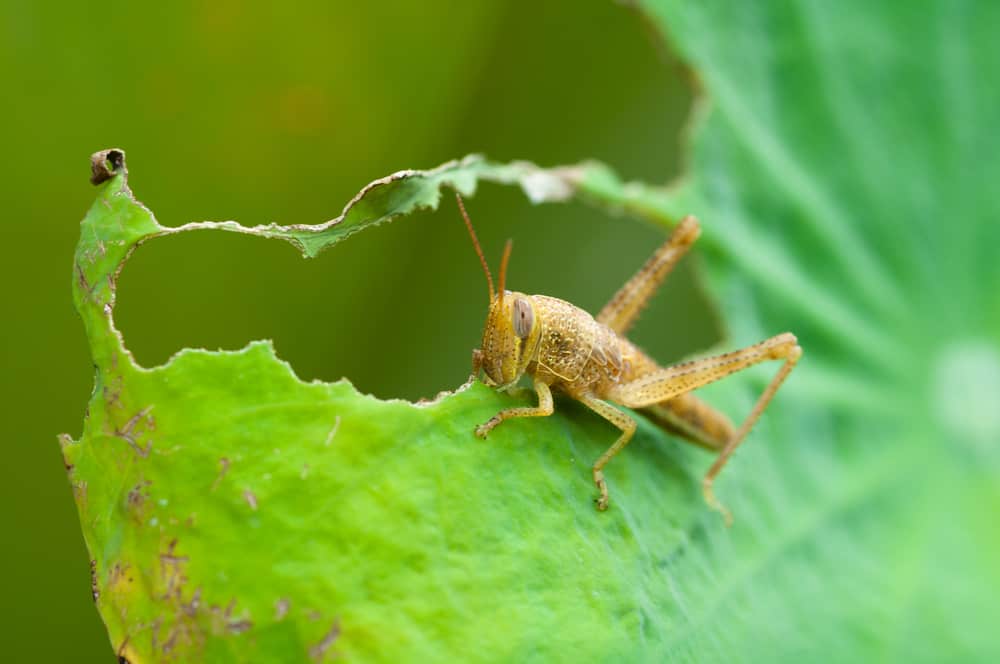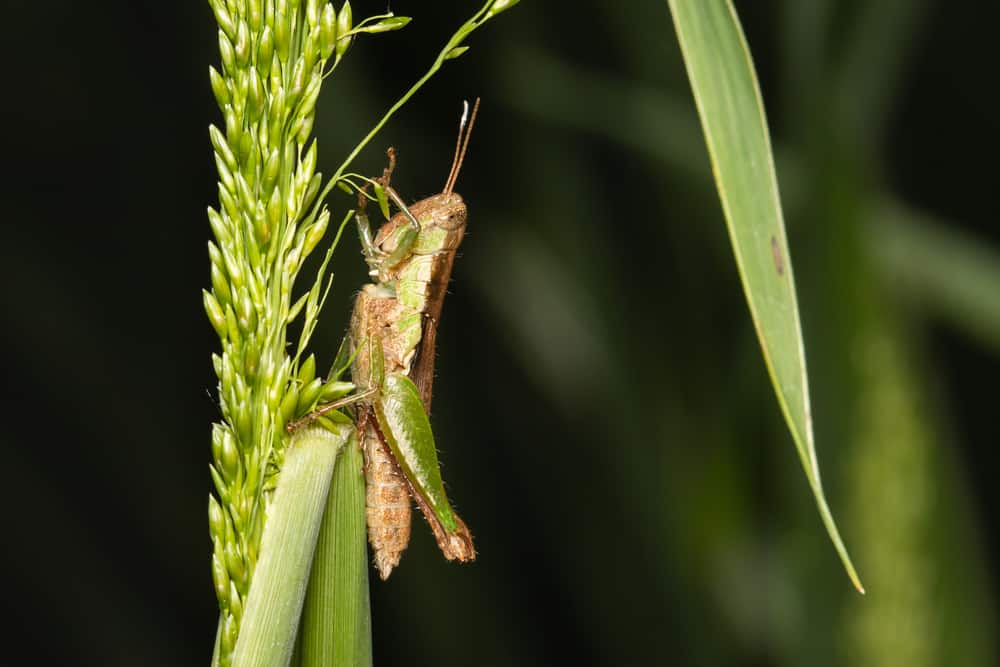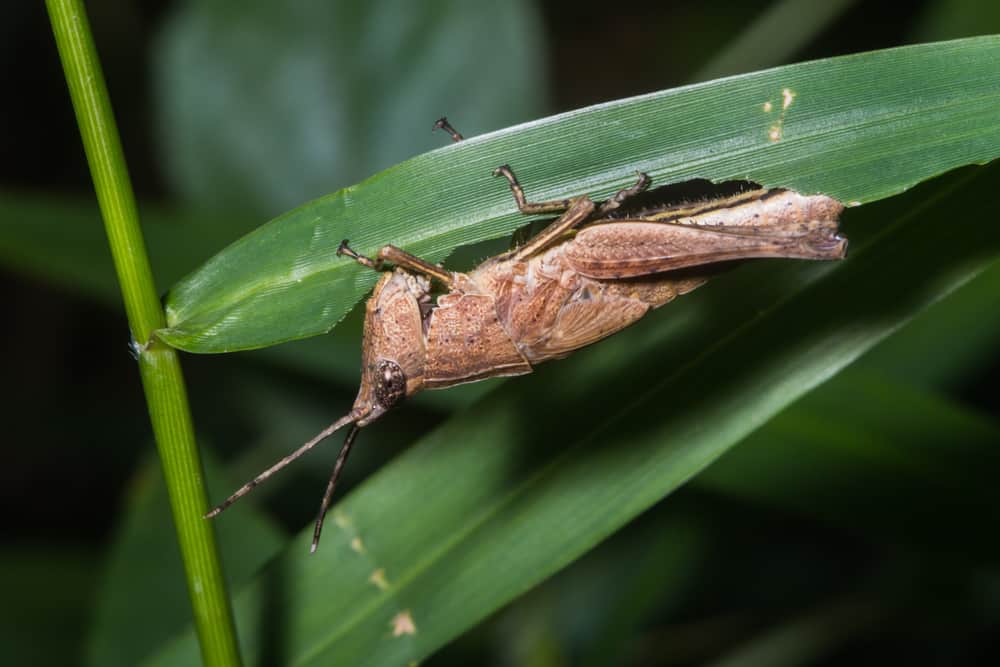When someone mentions a grasshopper, doesn’t it take you back in time to when you were a child? I’d like to believe it does. I’m sure you’ve tried catching one or two at least once before.
Despite these cat and mouse games we used to play, few people know what grasshoppers eat most. Let’s find out.
Grasshoppers Habits And Biology
Grasshoppers belong to the earliest group of chewing herbivores classified under the subgroup Caelifora. They are known plant-eaters, and some species are pests of crops such as cereal and pasture.
Did you know there are about 11,000 different species of grasshopper worldwide? Contrary to popular belief, grasshoppers and locusts are the same. Both belong to the order Orthoptera.
Under certain environmental conditions and large population densities, grasshoppers change their color and behavior to form swarms. Migratory species gather in millions or even billions.
Like all other animals, grasshoppers have adapted to their environment in several ways—these adaptations aid in protecting themselves from predators to feeding.
Grasshoppers protect themselves from predators using camouflage. When spotted, they use their brightly colored wings in hopes to scare away the predator. They also jump to escape predators.
Other species feed on toxic plants and keep the toxins in their bodies to discourage predators such as birds and frogs from making a meal out of them.
Grasshoppers are also known to ‘spit’ liquid from their mouths as a means of defense. Scientists believe that the liquid aids these bugs repel predators.
The liquid is commonly known as ‘tobacco juice.’ Also, historically, grasshoppers have been linked with tobacco crops.
Most species of grasshopper are active throughout the day but are also known to feed during nightfall. They spend most of their time foraging. An average grasshopper can eat 16 times its weight.
The insects chew using their modified mouth. The grasshoppers’ mouth pointed in a downward direction enabling it to chow down food quickly.
The little critters are herbivores by nature, and therefore their diet is primarily plant-based. Among the foods grasshoppers eat, most include species of the grass family, such as wheat and barley.
Others are omnivores, and they eat animal feces and tissue. During harsh conditions, some species depict cannibalistic behavior as they feed on their own kind.
Grasshoppers have specialized stomachs allowing them to digest some tough foods they ingest, such as dry grass.
Food is chewed and crushed by the grasshopper in the mouth, then passed to the crop (where food is stored). The crop digests carbohydrates, and the caecum (tube-like structure in grasshoppers’ abdomen) digests proteins.
An abundance of saliva predominantly free of enzymes helps move food to the Malpighian (excretory organs) tubules where waste excretion happens.
Through these numerous adaptations, grasshoppers flourish in different environments effortlessly.
What Do Grasshoppers Eat Most?
What grasshoppers eat depends a lot on their environment. They live in several habitats, from forests to prairies (immeasurable stretches of grassland) and desserts.
In nature, grasshoppers are polyphagous, meaning they possess the ability to consume a variety of foods. Vegetation is what grasshoppers eat most. But what else does their diet entail? Let’s find out.
- Grasshoppers are not picky about their food, especially in the wild, and would consume anything green. They mostly devour grasses, foliage, newly emerged shoots, and flowers.
- In the scarcity of greenery, they feed on barks, mosses, seeds, fungi, animal waste, decomposing meat, spider silk, and even insects like spiders, flies, and mosquitoes.
- In captivity, they primarily consume greenery. Grasshoppers make a meal of every type of vegetation, most especially canary grass and reed grass.
- Other food suitable for them in captivity includes corn, wheat, alfalfa, and other veggies.
- In dessert habitats, grasshoppers have omnivorous tendencies. An example is the Brachystela magna (Lubber grasshopper), which eats many plant species and feeds on insects and other grasshoppers.
- Baby grasshoppers, in other words, nymphs, lack entirely developed digestive systems. Hence, they are unable to digest tough plants their adult counterparts enjoy.
- For this reason, they only adapt to feeding tender parts of plants like shoots, grass, and cloves. Nymphs’ food sources are limited to their surrounding vegetation.
Foods To Avoid Feeding Grasshoppers
Despite grasshoppers being voracious eaters, there are a couple of food items these tiny creatures find distasteful. Some of the food substances may prove even harmful and threaten their survival.
Here are some of the items that grasshoppers do not feed on, as they consider them repellants:
- Dianthus –they usually produce pink or red flowers with white hues. Their spicy scent distinguishes them that grasshoppers dislike.
- Lilac –their colors range from purple to pink and even white. The plant has a strong smell that repels these bugs.
- Jasmine –these easy to care for plants yellow flowers are a characteristic of theirs. Grasshoppers detest them due to their very fragrant nature.
- Juniper –are creeping plants (grow close to the ground) known famed for their pleasing fragrance. Regardless grasshoppers prefer to keep away and not feed on them.
- Lavender
- Salvia –there exist different varieties of the fragrant, beautiful flowers. They usually attract butterflies for pollination but their insect counterparts, grasshoppers, are ward off by the plants’ scent.
- Verbena –also known as turtlehead, is found distasteful to grasshoppers as they find it bitter, and its strong fragrance is unappealing to the bug.
- Moss rose –is known by several names such as eleven o’clock, Mexican rose, or rock rose. The plant has white, orange, pink, variably red or yellow flowers. Grasshoppers avoid the plant because of its scent.
- Crepe myrtle –flowers come in a variety of colors. Though they are prone to pests like beetles, grasshoppers find them undesirable.
- Forsythia –are deciduous plants easily identified by their bright yellow flowers. They grow all year long and act as a repellant to pests like locusts.
- Lantana –has red and yellow flowers and is popularly known as the Spanish flag. Pests like locusts tend to avoid it due to their toxic components.
- Artemisia –are known for their solid scents and bitter taste that discourage pests such as beetles, aphids, and grasshoppers.
Other plants avoided by grasshoppers include commercially grown vegetables such as:
- Tomatoes
- Peas
- Squash
Even though grasshoppers do not prefer these plants, they may eat whatever vegetation is available to satisfy the appetite in times of scarcity.
Tips To Feeding Grasshoppers
Owning a pet grasshopper is an excellent alternative to owning high-maintenance pets such as cats, dogs, or even birds.
Though the minimal effort is required to care for the animal, you are still required to provide and keep tabs on them. Below are simple steps on how to care for and feed grasshoppers:
- For baby grasshoppers, place food near them –as they are puny and feeble and can’t move around much. Ensure to put the food as close to them as possible so that they can access it.
- Avoid picking them up. Nymphs’ small stature makes them very fragile and hence can be easily injured. Try to keep them in their enclosure as much as possible.
- Ensure you feed them tender plants. Nymphs easily digest tender plants such as clovers and fresh grass shoots.
- When feeding adult grasshoppers, you need to do your homework. You should be aware of what they like to eat. As previously discussed, adult grasshoppers prefer foods from the grass family (e.g., wheat and barley) most.
- Feed your grasshoppers an assortment of foods. Significant chemicals in their stomach and saliva enable them to break down carbohydrates in drier plants and utilize them for energy.
- Feed them green plants and leaves.
- Feed them your leftover veggies. Grasshoppers will eat cabbages, lettuce, kale, spinach, and other vegetables. Make sure to wash the veggies thoroughly to rid them of pesticides before feeding your grasshoppers.
- Master how to prevent locust feeding habits. When many grasshoppers occupy the same space, a chemical reaction is triggered, and they grow a lot larger and lay eggs more rapidly.
- When locusts form, they swarm together and consume virtually all vegetation in their path.
- Ensure your grasshopper has sufficient room to roam and flourish in whichever container you have them in. Avoid putting a lot of grasshoppers together in the same container.
When you adhere to the above pointers to the latter, your grasshoppers are guaranteed to thrive and live long, healthy lives.
Frequently Asked Questions
Do grasshoppers bite?
Yes, grasshoppers bite, but on rare occasions. When grasshoppers congregate to form swarms of locusts, they become aggressive and may bite.
Do grasshoppers drink water?
Grasshoppers attain water from the plant materials they eat.
Can you eat grasshoppers?
Yes. Insects such as grasshoppers and crickets are rich in proteins and are eaten in countries worldwide such as China, Japan, Ghana, Uganda, and many more.
Summary
Grasses are by far these bugs’ favorite dish on the menu. Now we know what grasshoppers eat most. These insects are well adapted to their environment and are undoubtedly one of the most resilient bugs on the food chain.
Grasshoppers are here to stay. Regardless, they make good pets if looked after correctly, as their needs are basic.



tis is a nice web for animal caring
thanks for the tips
pls play the games that i gave to you